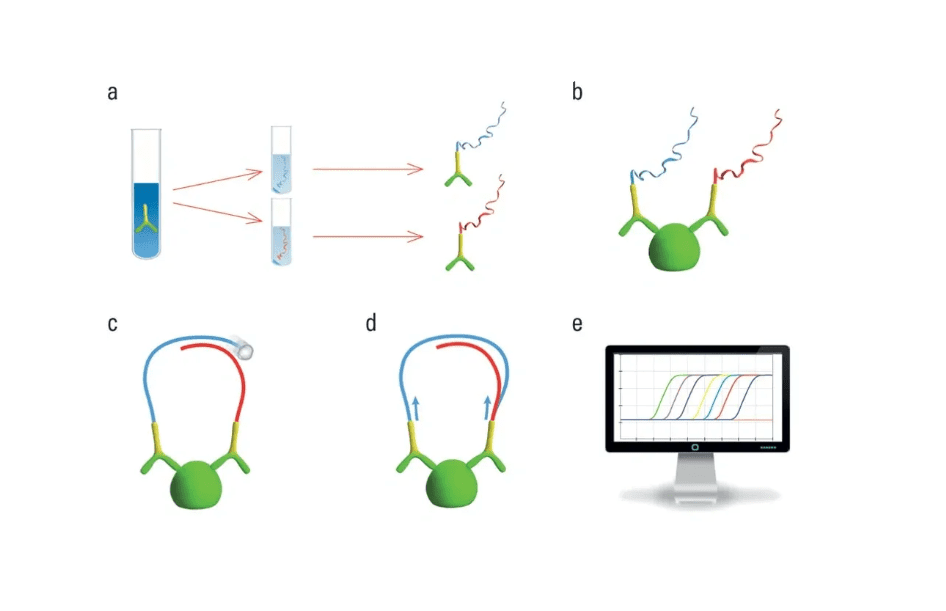Olink® Assay
Olink® was founded in 2004 in Uppsala, Sweden, with the goal of transforming protein biomarker discovery through precise, high-throughput proteomics. The company pioneered the Proximity Extension Assay (PEA) — a proprietary technology that uses pairs of antibodies linked to DNA tags to convert protein detection into a DNA-based signal, enabling exceptional sensitivity, specificity, and scalability. This innovation allows researchers to measure thousands of proteins simultaneously from as little as one microliter of sample.
Now part of Thermo Fisher Scientific, Olink® continues to lead the field of proteomic profiling, empowering scientists to uncover complex biological mechanisms and identify predictive biomarkers in health and disease.
At Axela Biosciences, we leverage Olink® technology to deliver comprehensive proteomic profiling services, supporting translational research, biomarker validation, and drug development. Our Olink-based assays provide high-quality, reproducible insights to accelerate data-driven discovery.
Olink® is a registered trademark of Olink Holding AB. Proximity Extension Assay (PEA) is a proprietary technology of Olink Proteomics.
The Olink® proteomics assay is designed to comprehensively profile the low-abundance plasma proteome, covering all major biological pathways and disease-relevant functions. It enables investigation across diverse disease areas, including cardiovascular disease, oncology, neurology, inflammation, and immuno-oncology, and supports studies of cardio-metabolism, cellular regulation, immune responses, developmental biology, metabolism, and organ damage assessment.
This high-throughput platform supports approximately 3,000 multiplex assays while preserving both sensitivity and specificity. It accurately captures the wide dynamic range of the plasma proteome and produces reproducible, high-quality proteomic data. In-well controls are incorporated at each assay step to safeguard data integrity without requiring replicates, while comprehensive assay-level quality controls provide visibility into technical performance as well as sample-level variability.
Furthermore, every assay well contains dedicated calibrators and controls to maintain assay accuracy and parallelism, ensuring consistent results across samples and experimental conditions.
Use Olink® for 1) Broad Biomarker Discovery 2) Low Abandance Protein Detection 3) Longitudinal or multicenter consistency
How It Works

Target-specific antibodies are first conjugated to unique DNA oligonucleotides (blue and red), generating PEA probes A and B. These probes are then incubated with the samples, along with a dilution series of the antigen standard in either a 96-well plate or test tubes, which facilitates binding to the target protein.
When two probes bind in close proximity, a DNA polymerization event occurs, leading to the creation of unique real-time PCR amplicons. The resulting extension products are then combined with a real-time PCR mix and subsequently amplified within a real-time PCR instrument. This process enables highly sensitive and specific quantification of the target proteins.
Protein Biomarker Measurement with Olink® Proteomics
Protein biomarkers, together with other omics markers, play a crucial role in predicting drug response, stratifying patient populations, and uncovering insights into disease biology.
Olink® assays provide a high-throughput solution for the discovery of protein biomarkers through rigorously validated methods that deliver exceptional specificity at high multiplex levels. By leveraging Olink Proteomics® Proximity Extension Assay (PEA) technology, Axela’s protein biomarker immunoassay services enable precise detection and quantification of circulating proteins. This allows for a deeper understanding of disease biology and drug efficacy.
To support a true multiomics approach, this proteomics service can be seamlessly integrated with Axela’s other high-throughput and multiplex platforms. Together, they provide a comprehensive view of molecular changes driving development, disease progression, and therapeutic response—supporting both preclinical studies and clinical trials.
Proximity Extension Assay (PEA) technology
The Olink® Proximity Extension Assay (PEA) utilizes an innovative dual-recognition, DNA-coupled methodology that delivers exceptional specificity and sensitivity in protein detection. Unlike conventional methods, the Olink assay overcomes common challenges by offering a robust and elegant DNA-based counting system.
This method employs two matched antibodies for each target antigen, with each antibody conjugated to a unique complementary DNA oligo tag, referred to as a “DNA barcode.” When both antibodies bind to the same target protein in solution, the DNA oligos are brought into close proximity and hybridize, enabling DNA extension. Each antibody pair thereby generates a distinct DNA barcode, which is subsequently amplified and quantified using qPCR or sequencing techniques.
Key Advantages of Olink® Proteomics Assays

Service features
We provide fully validated, quality-controlled assays with flexible design options, including pre-made panels (92 or 45 proteins) or customizable panels of up to 21 proteins. Our platform is robust, reproducible, and scalable for both small and large studies, utilizing the Fluidigm® BioMark™ HD system for precise readouts.
With a fast turnaround of 2–4 weeks, results are delivered in a concise, publication-ready report, ensuring reliable data and accelerated research outcomes.

Sample requirements
Our assays require only minimal sample consumption—as little as 1 μL of plasma or serum—thanks to the sensitivity of microfluidic qPCR–based DNA amplicon quantification. For accurate pipetting, however, we recommend submitting approximately 20 μL of sample.
We accept a wide range of biological sample types, including serum, plasma, and most other commonly used biological materials.

Popular assay panels
The Olink® Target 96 and Target 48 panels focus on specific disease biology, enabling relative quantification of up to 92 proteins across 88 samples simultaneously. For added flexibility, Olink® Flex allows selection of up to 21 proteins from a library of ~200 validated biomarkers, with absolute quantification for 21 assays per panel and capacity for 40 samples per kit. Olink® Focus further offers fully customized panels of up to 21 proteins tailored to specific research needs.
FAQ: Luminex vs. Olink® Assays
We offer two different multiplex assays for cytokine detection, Luminex and Olink. These assays use different technologies, and have panels targeting different but overlapping sets of cytokines for Luminex and for Olink.
✅ Which assay is the most sensitive?
Both platforms provide high sensitivity in the low pg/mL range, though performance may vary by analyte. For example, Luminex often shows better sensitivity for IL-4, IL-5, and IL-33, while Olink offers comparable sensitivity across a broader range of cytokines.
✅ Is there a difference in sample requirements?
Yes. Olink requires only ~20 μL of sample, while Luminex typically needs ~100 μL for serum/plasma and 200 μL for supernatants or homogenates. Both handle matrices such as serum, plasma, and tissue lysates, but consistency in sample type across assays is essential.
✅ What about price and number of samples?
Luminex panels are priced per sample, regardless of the number submitted, and can process up to 46 duplicate samples or 92 singlets per run. Olink assays are priced per array, with a fixed format accommodating up to 88 samples plus controls. Olink becomes more cost-effective when larger numbers of samples are analyzed.
✅ Are there batch effects?
As with any assay, some run-to-run variability may occur, but both platforms employ methods that minimize batch effects.
✅ Are there other technical issues?
Multiplex assays can be affected by nonspecific binding or cross-reactivity. Luminex has established methods to reduce nonspecific binding (see J Immunol 204:3425–3433), while Olink’s design inherently limits this issue.
✅ Should samples be run in duplicate?
For Luminex, duplicates or triplicates are generally recommended to reduce technical variability, especially in stimulation experiments or longitudinal studies. For Olink, technical coefficients of variation are low, making replicates less necessary.
✅ Can multiple assays be run on the same samples?
Yes, as long as sufficient sample volume is available. Sequential runs may introduce minor freeze–thaw effects, which usually do not significantly affect most cytokines but could impact sensitive ones. Minimizing freeze–thaw cycles is recommended.
More Assay Panels
Olink® Target 96 and 48 panels are designed to accelerate targeted protein biomarker discovery, enabling faster and better-informed decisions. These high-multiplex immunoassays maintain exceptional data quality and performance, with protein categorization supported by public-access bioinformatic databases such as UniProt, Human Protein Atlas, and Gene Ontology (GO).
✔ Olink Target 48 Cytokine Panels – proteins linked to inflammation and immune regulation
✔ Olink Target 96 Immuno-Oncology Panels – proteins associated with immune response and immunotherapy
✔ Olink Target 96 Biological Process Panels – coverage of key processes including cell regulation, development, metabolism, and organ damage
✔ Olink Target 96 Oncology Panels – proteins tied to cancer biology, such as angiogenesis, apoptosis, cell signaling, and differentiation
✔ Olink Target 96 Neurology Panels – proteins related to neurological functions and diseases
✔ Olink Target 96 Cardiovascular Panels – proteins linked to cardiovascular biology and disease
For more information about our Olink® proteomics services, please contact info@axelabio.com, or explore Olink’s assay options using these links: Olink Target Panels, Olink Flex, and Olink Focus. Our scientists can also assist with designing customized panels to support specific biomarker discovery needs.